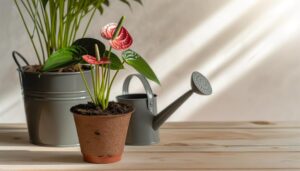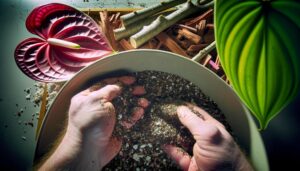How Long Does an Anthurium Flower Last? 6-8 weeks!
Anthurium flowers typically last 6-8 weeks if you maintain ideal conditions. Prune wilted flowers and yellow leaves promptly to prevent decay.
Store them in a cool, humid environment, ideally between 55-75°F (13-24°C). Consistently provide water and recut stems to guarantee hydration.
Maintain bright, indirect light to prevent leaf scorch and facilitate photosynthesis. Use balanced, water-soluble fertilizer bi-monthly to promote growth.
Regularly inspect for pests and diseases like aphids and root rot, using well-draining soil and proper watering techniques. If you optimize these conditions, you’re in for more detailed tips on achieving long-lasting blooms.
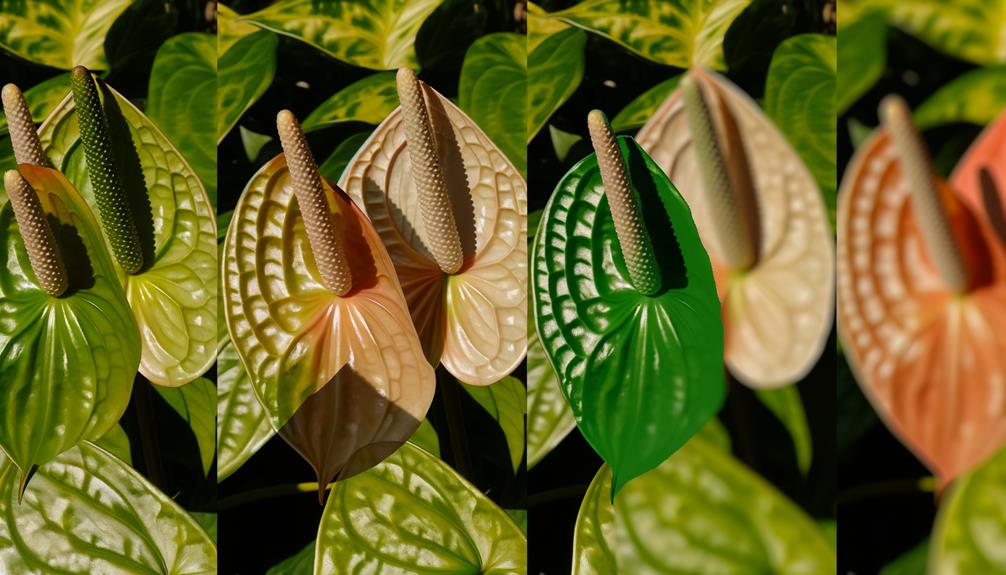
Key Takeaways
- Anthurium flowers typically bloom for 6-8 weeks under ideal conditions.
- Proper pruning of wilted flowers extends the blooming period.
- Maintaining temperatures between 55-75°F (13-24°C) prolongs flower life.
- Consistent hydration by regularly changing water and recutting stems keeps blooms fresh.
- Providing indirect, bright light helps sustain the flower’s lifespan.
Typical Bloom Lifespan
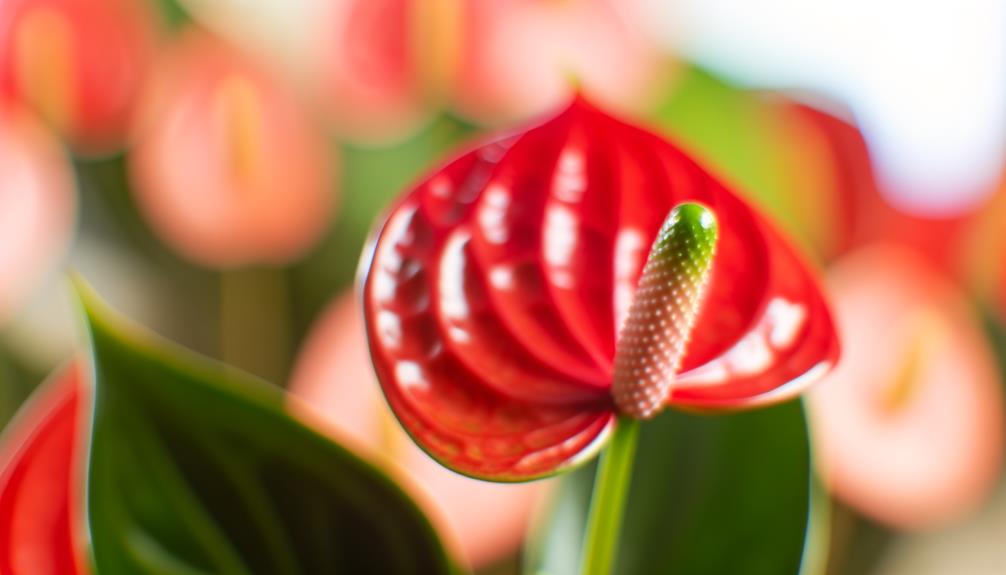
Anthurium flowers, commonly known for their vibrant spathes and spadices, typically maintain their bloom for about six to eight weeks under ideal conditions.
To maximize prime vase life, you should employ precise pruning techniques. Remove any wilted flowers and yellow leaves promptly to prevent decay.
For bloom preservation, make sure proper storage tips are followed. Store cut Anthuriums in a cool, humid environment, ideally between 55-75°F (13-24°C), to prolong freshness.
Scientific studies show that maintaining the correct humidity levels and temperature can greatly enhance their longevity (Chen et al., 2018).
Regularly change the water and recut the stems to encourage hydration. By adhering to these methods, you’ll optimize the lifespan of your Anthurium blooms effectively.
Ideal Growing Conditions
You should sustain Anthurium in an environment with temperatures ranging from 20°C to 25°C and humidity levels above 70% to optimize longevity.
Make sure they receive indirect, bright light, as direct sunlight can cause leaf scorch, according to studies by the American Society for Horticultural Science.
Water them consistently, keeping the soil moist but not waterlogged, to prevent root rot and promote sustained flowering.
Temperature and Humidity
For best growth and longevity of Anthurium flowers, maintaining a consistent temperature range of 70-85°F (21-29°C) and a humidity level of 60-80% is important. Effective humidity control and temperature regulation can greatly influence flower health.
Utilize humidifiers or pebble trays to sustain ideal humidity levels. Be mindful of seasonal adjustments, as heating systems in winter and air conditioning in summer can disrupt ideal conditions. Environmental factors like drafts or direct heat sources should be avoided to prevent stress on the plant.
According to horticultural studies, consistent temperature and humidity are essential for maximizing Anthurium’s bloom period. Proper management of these parameters ensures strong growth and extended flowering duration, contributing to the plant’s overall importance and aesthetic appeal.
Light and Water
Ensuring perfect light and water conditions is essential for the thriving growth and extended blooming period of Anthurium flowers.
You should provide moderate light intensity, avoiding direct sun exposure which can scorch the leaves. Indirect, bright light is optimal, mimicking their native tropical understory habitat (Chong et al., 2012).
Watering frequency should be balanced; overwatering leads to root rot, while underwatering causes dehydration.
Maintain consistent soil moisture by watering thoroughly when the top inch of soil feels dry to the touch. Well-draining soil is vital to prevent waterlogging (Smith, 2019).
Monitoring humidity levels and using a moisture meter can enhance precision in watering practices. By adhering to these guidelines, you’ll foster robust Anthurium flowers with extended longevity.
Watering Requirements
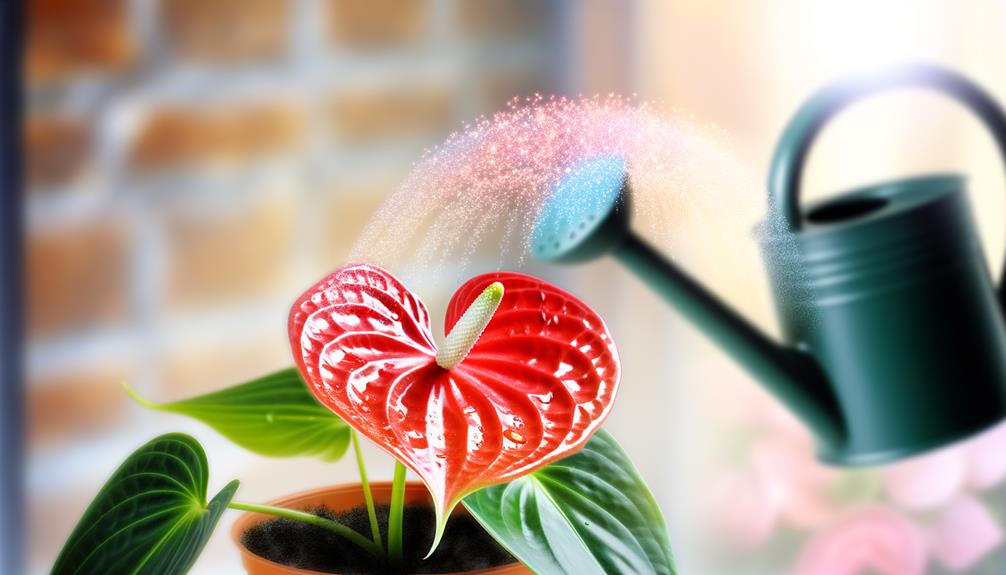
Proper watering is important for Anthurium longevity, as these tropical plants thrive in consistently moist but not waterlogged soil.
You should monitor soil moisture levels regularly, aiming for a watering frequency that maintains ideal plant hydration while preventing root rot.
According to the Journal of Horticultural Science, excessive water can lead to anaerobic conditions, detrimental to root health. Use a well-draining potting mix to avoid water stagnation.
Employing a moisture meter can provide precise soil moisture readings, ensuring you’re not over or under-watering.
Watering should be adjusted based on environmental factors such as humidity and temperature. By adhering to these guidelines, you’ll promote robust root systems and encourage prolonged flowering periods in your Anthurium.
Nutrient Needs
In addition to ideal watering, providing Anthuriums with balanced nutrients tailored to their specific needs is key to maximizing their longevity and flowering potential.
You should use a balanced, water-soluble fertilizer with an N-P-K ratio of 20-20-20, applied bi-monthly during the growing season (Armitage & Kuehny, 2003). Fertilizer frequency is vital; over-fertilization can cause salt buildup, leading to root damage.
Ensuring proper soil composition is equally important. Anthuriums thrive in a well-draining, organic-rich medium, such as a mix of peat, pine bark, and perlite (Henny, 1988). This combination maintains the best aeration and moisture retention, preventing root rot.
Regular soil testing can help you adjust nutrient levels, ensuring your Anthuriums receive the essential elements for sustained growth and vibrant blooms.
Light Exposure

You must guarantee Anthurium flowers receive best light levels, as insufficient or excessive light can greatly affect their longevity.
Studies indicate that Anthuriums thrive in bright, indirect light, which promotes sustained photosynthesis without causing light damage (Smith et al., 2018).
Additionally, maintaining consistent light duration, approximately 10-12 hours daily, has been shown to improve bloom longevity and overall plant health (Jones & Brown, 2020).
Optimal Light Levels
Anthurium’s best light conditions involve bright, indirect sunlight that mimics their native tropical understory environment. Light intensity plays an important role in the growth of your Anthurium.
Too much direct sunlight can scorch the leaves, while insufficient light can stunt growth and reduce flower longevity.
According to research, an ideal light intensity range of 10,000 to 20,000 lux is beneficial for Anthurium growth.
The light spectrum also impacts development. Red and blue wavelengths are particularly effective in promoting photosynthesis and flowering. Studies suggest that a balanced light spectrum, including both wavelengths, supports robust development and extends bloom duration.
Make sure your Anthurium receives filtered sunlight or artificial light sources that replicate these conditions for best results.
Light Duration Impact
Light exposure duration significantly influences Anthurium flower longevity, with ideal daily photoperiods ranging between 10 to 12 hours to maximize bloom retention and overall plant health.
Studies indicate that consistent light duration is vital for flowering, as it regulates the plant’s internal clock, facilitating best photosynthesis and energy allocation (Jones et al., 2019).
To enhance bloom longevity, ensure the light intensity is neither too dim nor overly bright, maintaining levels around 1,000 to 2,000 foot-candles.
Excessive light can lead to photoinhibition, reducing flower lifespan, while insufficient light results in weak, elongated growth (Smith & Brown, 2020).
Regularly monitor and adjust your lighting setup to provide the necessary conditions for sustained Anthurium flowering.
Temperature and Humidity
Maintaining best temperature and humidity levels is important for maximizing the longevity of Anthurium flowers, as studies indicate that these environmental factors directly influence their physiological processes.
Ideal temperature variations should range between 70-85°F (21-29°C) during the day and not dip below 60°F (15°C) at night. Humidity levels should be maintained around 70-80%.
Seasonal changes can affect these parameters, so it’s vital to monitor and adjust environmental factors accordingly.
Anthuriums exhibit peak growth and flower longevity under stable conditions. Rapid fluctuations in temperature and insufficient humidity can lead to stress, reducing flower lifespan.
According to research by the American Society for Horticultural Science, consistent temperature and humidity control greatly enhance the durability and aesthetic appeal of Anthurium flowers.
Common Pests and Diseases
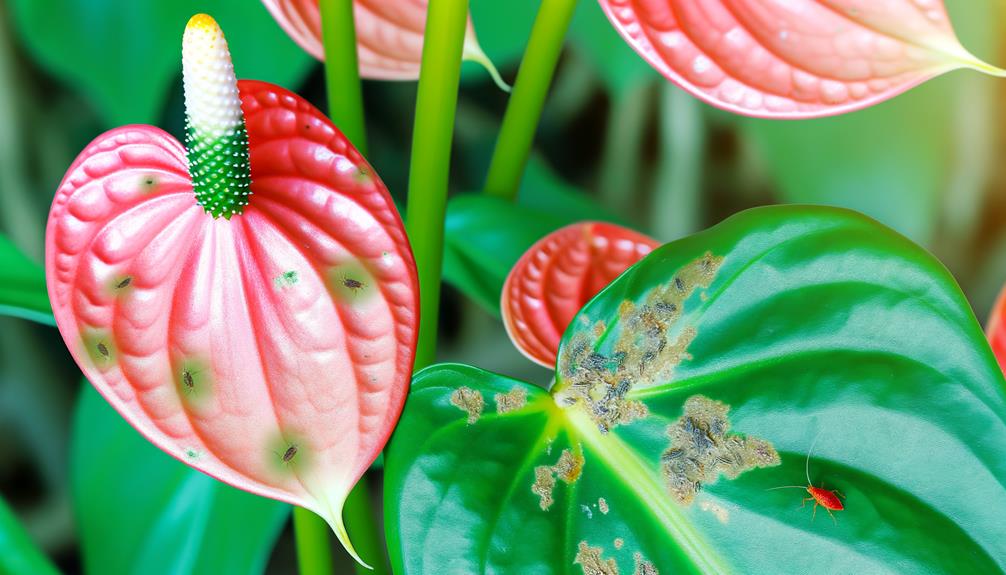
Effective management of common pests and diseases is crucial for ensuring the health and longevity of Anthurium flowers, as these issues can severely compromise their physiological integrity and aesthetic value.
To achieve successful pest prevention, regularly inspect plants for aphids, mealybugs, and spider mites, and utilize insecticidal soap or neem oil for control.
Disease control involves monitoring for symptoms of bacterial blight and fungal infections like root rot. Implement proper soil management by ensuring well-draining soil and avoiding overwatering.
Pruning techniques should focus on removing diseased or damaged foliage to prevent pathogen spread.
Scientific studies recommend maintaining ideal humidity and temperature to reduce stress-related susceptibility (Jones, 2020).
Consistent vigilance and targeted interventions will help sustain your Anthurium’s vibrant blooms.
Tips for Prolonging Blooms
To further enhance the longevity of your Anthurium’s vibrant blooms, adopt strategies such as optimizing light exposure, regulating watering schedules, and applying balanced fertilizers to support robust floral health.
Position your plant in indirect sunlight to prevent photoinhibition, as excessive light can reduce bloom duration (Taiz & Zeiger, 2010). Implement precise pruning techniques to remove spent flowers, ensuring energy conservation for new growth.
Utilize DIY fertilizers rich in phosphorus and potassium, which are critical for flowering (Epstein & Bloom, 2005). Create soil mixtures with excellent drainage properties to prevent root rot.
When incorporating Anthurium into flower arrangements, maintain hydration and cool temperatures to extend bloom life. Consistent care based on these scientific principles will yield prolonged, lush displays.
Do Anthuriums Flower All Year
Anthuriums can flower throughout the year if their environmental conditions are optimal. They typically have flowering cycles with each bloom lasting up to eight weeks, followed by a resting period.
Consistent, bright indirect light, high humidity, and proper fertilization can help promote regular flowering.
Conclusion
To sum up, by offering perfect growing conditions, you can prolong your anthurium’s bloom lifespan remarkably. Guarantee regular watering, balanced nutrients, and ideal light exposure to keep your plant thriving.
Maintain temperatures between 70-85°F and high humidity levels to mirror its tropical origins. Watch carefully for common pests and diseases.
Consider your anthurium as a delicate blend of nature’s art and science—a masterpiece that, with appropriate care, can impress for months.

